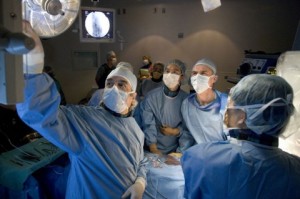Cardiac Surgery Procedures
Cooling the body to extreme temperatures makes cutting-edge procedures possible.
During cardiac surgery, the heart sometimes needs to be stopped to allow surgeons to perform delicate procedures, such as replacing valves. If left uncorrected, the subsequent lack of oxygen supply would lead to brain damage within minutes. Cardiopulmonary bypass can overcome most of these effects, although it is technically not possible in all patients.
Hypothermic cardiac surgery can now be used to overcome these limitations. The body is cooled from its normal 37 degrees Celsius (98.6 degrees Fahrenheit) to as low as 24 degrees Celsius (75.2 degrees Fahrenheit). Cold saline solutions are infused into the bloodstream via the major vessels and the heart is surrounded by ice. This stabilizes cell membranes and reduces the metabolic rate. Once cool enough, the heart is stopped using a potassium-rich solution. In this reduced oxygen-dependent state, the body can temporarily survive without the heart beating.
When surgery is completed, the potassium solution is rinsed out and the body re-warmed before the heart is restarted. Hypothermic cooling isn’t without its risks, however; there is a chance that once a procedure is finished and the body re-warmed, the heart might not restart.
Super-cold surgery step-by-step
 Hypothermic surgery requires a deep understanding of how cells work at a molecular level.
Hypothermic surgery requires a deep understanding of how cells work at a molecular level.
1. Cooling – Using cold saline solutions infused into the circulation and ice placed around the heart, the body’s core temperature is reduced.
2. Cardioplegia – A potassium-rich solution is used to paralyze the heart muscles – a process known as cardioplegia.
3. Cell membrane – The cold temperature stabilizes ion transfer across cell membranes in the body, protecting them from the low-oxygen state.
4. Warming up – Once surgery is done, the body is re-warmed slowly. The cells start to re-function as oxygen returns to them.
5. Jump-start – The crucial moment comes when defibrillators are placed against the heart’s muscular wall and an electrical current is used to shock it back to a beating state.

